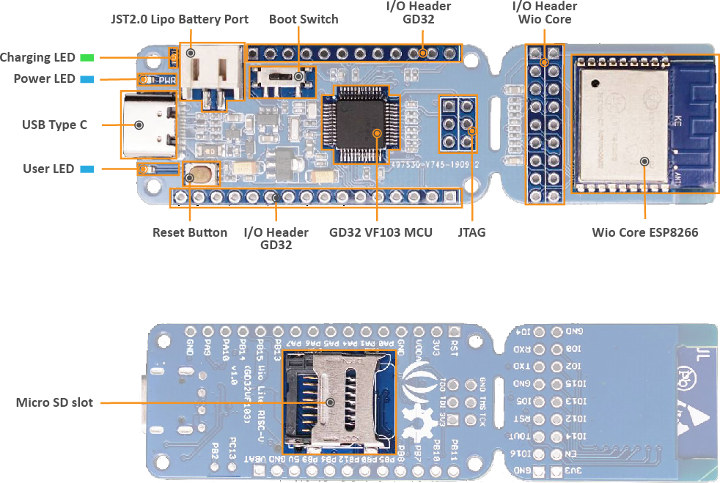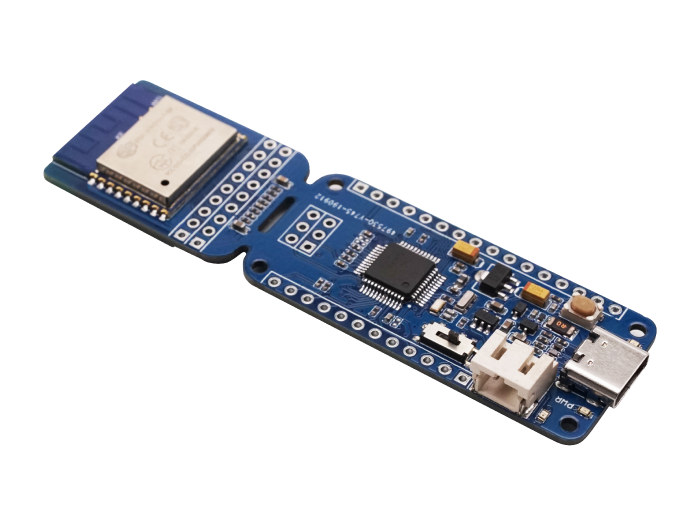Released this summer, GigaDevice GD32V generated a lot of buzz, as a cheap general-purpose 32-bit RISC-V MCU, and soon after the $5 Longan Nano development board with LCD display and enclosure was launched to the market.
However, many applications benefit or require some network connectivity with WiFi. Espressif Systems is a founding member of the RISC-V Foundation, so RISC-V WiSoCs (Wireless SoCs) are coming, but AFAIK none of those are available yet. In the meantime, Seeed Studio has launched Wio Lite RISC-V board which brings WiFi connectivity to GD32V MCU through an ESP8266 WiFi module.
- MCU – Gigadevice GD32VF103CBT6 RISC-V (rv32imac) microcontroller @ 108 MHz with 128KB Flash, 32KB SRAM
- Wireless Module – ESP8266 WiFi Wio Core with 802.11b/g/n/ WiFi 4 connectivity
- Storage – MicroSD card slot
- USB – 1x USB Type-C port for power and programming
- Expansion – I/O headers for GD32 MCU, I/O header for Wio core ESP8266 module
- Debugging – Unpopulated 6-pin JTAG header
- Misc – Power, charging and user LEDs; reset button, boot switch
- Power Supply – 5V via USB Type-C port, JST2.0 Lipo battery header
- Power Consumption – RISC-V core power consumption is only 1/3 of that of a traditional Cortex-M3.
- Dimensions – Feather form factor

Currently, there’s no documentation, except some photos and the EAGLE & PDF schematics & PCB layout on Github. But I’d expect the board to have a similar development environment as Longan Nano with support for RT-Thread & LiteOS operating systems, and tools such as PlatformIO IDE, Arduino IDE, GCC, and OpenOCD. More documentation should eventually be made available on Seeed Studio’s Wiki.
The GD32V part of the board follows Adafruit Feather form factor so you’ll benefit from Featherwing add-on board compatibility, and since it’s a Wio Lite board, it will also work with Grove Shield for Wio Lite so you can add whatever Grove sensor or module to the board just like in Arm-based Wio Lite W600.
While the latter sells for $9.95, Wio Link RISC-V WiFi board is up for pre-order for $6.90 with shipping scheduled to start at the end of November.
Many people will still likely prefer using an ESP8266 board such as Wemos D1 mini since it now sells for under $2 including shipping, but Wio Link RISC-V may still be interesting to people wanting to play with RISC-V, or for battery operated projector since battery support is included and the board may consume less (TBC) than competing solutions. This also means that eventually, maybe next year, RISC-V WiFi and/or Bluetooth boards for less than $2 are likely.

Jean-Luc started CNX Software in 2010 as a part-time endeavor, before quitting his job as a software engineering manager, and starting to write daily news, and reviews full time later in 2011.
Support CNX Software! Donate via cryptocurrencies, become a Patron on Patreon, or purchase goods on Amazon or Aliexpress





